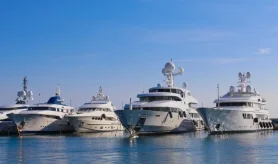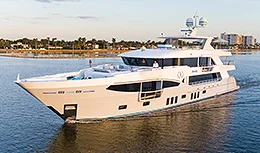- Alaskan Yachts
- Azimut Yachts
- Back Cove Yachts
- Beneteau Yachts
- Benetti Superyachts
- Bertram Yachts
- Boston Whaler
- Broward Yachts
- Buddy Davis Sportfish
- Burger Yachts
- Cabo Yachts
- Catamarans
- Carver Motoryachts
- Center Console
- Chris-Craft Yachts
- Cruisers Yachts
- DeFever Trawlers
- Dufour Sailboats
- Fairline Yachts
- Feadship Yachts
- Ferretti Yachts
- Filippetti Yachts
- Formula Yachts
- Fountaine Pajot Cats
- Grady-White
- Grand Banks Trawlers
- Hargrave Yachts
- Hatteras Yachts
- Hinckley Picnic Boats
- Horizon Yachts
- Hydra-Sports
- Intrepid Boats
- Jarrett Bay Sportfish
- Jeanneau Yachts
- Kadey-Krogen Trawlers
- Lazzara Yachts
- Lekker Boats
- Luhrs Sportfish
- Marlow Yachts
- Maritimo Yachts
- Marquis Yachts
- Mazu Yachts
- McKinna Motoryachts
- Meridian Yachts
- Midnight Express
- MJM Yachts
- Mochi Craft
- Neptunus Motoryachts
- Nordhavn Trawlers
- Nordic Tugs
- Numarine Yachts
- Ocean Alexander Yachts
- Ocean King
- Offshore Yachts
- Outer Reef
- Oyster Sailing Yachts
- Pacific Mariner Yachts
- Palmer Johnson Yachts
340 Sea Ray
![]()

Source: Peter Bohr, Sea Magazine
No matter what you call it, Sea Ray’s 340 midcabin was one successful boat
As one of the world’s major boat builders, Sea Ray can probably make quite a few claims to fame. But the midcabin layout featured in the company’s Sundancer series is certainly one of Sea Ray’s most significant contributions to yacht design.
At Sea Ray’s Merritt Island boat building plant, south of the Kennedy Space Center in Florida, they call these Sundancers “DAs.” Sea Ray’s in-house designer, Jerry Michalak, came up with the midcabin concept during the 1970s as a way of squeezing an extra sleeping area into what otherwise might be underutilized space.
As found in the 340 Sundancer — one of the company’s most successful boats — the midcabin is tucked beneath the bridgedeck. It’s separated from the main cabin by a privacy curtain, and there’s sitting room only on its double berth. But it is an ideal cabin for kids, making the 340 DA a true two-stateroom boat.
That isn’t something that can be said of the 340 Sundancer’s two sister models, the 340 Sedan Bridge and the 340 Express Cruiser, which have strictly single-stateroom layouts. These two share the same solid-fiberglass hull as the 340 Sundancer — one with a deep-V configuration and a fairly wide beam.
All three also have recessed propeller pockets, or “propulsion modules,” as Sea Ray officially calls them.
“The modules allow us to place the engine deeper in the hull, giving deeper cockpit area,” explained Doug Nieuwkoop, a Sea Ray production engineer. “But the modules also mean the boats can go into shallower waters.”
The 340 Sedan Bridge, the first of the three boats, went into production in 1983. The boat has a conventional-looking convertible profile, with a flying bridge above the main saloon. Many came with an optional lower helm, as well.
In the saloon, there’s room for a settee and a pair of club chairs. Large wrap-around windows make the saloon feel especially spacious.
Forward and down a couple of steps is a small galley, a dinette and a head compartment, which contains a combination shower stall and toilet. The forward stateroom, separated by a folding door, carries a centerline double berth. The cockpit isn’t large, but a transom door and a swim platform were standard amenities.
A year later, in 1984, the 340 Sundancer and the 340 Express Cruiser joined the 340 Sedan Bridge in the Sea Ray line. Both have the same exterior sportboat styling — with a sleek foredeck, a low bridge deck, a radar arch and a good-sized cockpit with a transom door and a standard swim platform.
What’s the difference between the two boats? The Sundancer’s midcabin.
While the Express Cruiser has only a single forward stateroom (like the Sedan Bridge), the Sundancer has the additional midcabin.
Michalak accomplished this feat by moving the engines aft and using V-drives. In addition, he also reduced fuel tankage — from more than 200 gallons in the Express Cruiser to 172 gallons in the Sundancer.
Though the Sedan Bridge was a brisk seller, especially in the Pacific Northwest, the Sundancer was the most popular model in many West Coast markets. “The midcabin made it seem like it was a lot more boat for the money, especially compared to the Express,” said Gary Scheck of Hardin Marine, a Newport Beach, California Sea Ray dealer.
The Sundancer and the Express Cruiser both have their galley, dinette and head compartment in the main cabin, and a separate stateroom up forward, containing a centerline island berth.
During the Sundancer and Express Cruiser production runs, which lasted from 1984 to 1989, Sea Ray made some notable changes in the interior. The galley and dinette were reconfigured (the galley grew in size, while the dinette shrank slightly) in 1986. At the same time, Sea Ray substituted cherry wood trim for the earlier boat’s teak trim and updated fabrics to give the interiors a lighter, more contemporary look.
In 1988, Sea Ray also put a larger, full-width berth in the Sundancer and Express Cruiser in place of the island berth.
Some early 340 Sea Rays came with twin Crusader gasoline engines, but the vast majority of 340s have twin MerCruisers. These were typically 340 hp, 454 cubic inch gasoline powerplants that gave a top speed of 34 knots and a cruising speed of 26 knots in both the Sundancer and Express Cruiser.
Sedan Bridge speeds were about 3 knots slower. Fuel consumption was 28 gallons per hour (gph) at cruise for both engines, and 49 gph at wide open throttle, according to Sea Ray.
While Sea Ray may be a high-volume, mass producer of moderately priced boats, the company certainly doesn’t cut corners in quality, according to Gary Stevens, a pleasureboat surveyor with Maritime Consultants of Newport Beach, California. His surveys of these Sea Rays usually uncover no major problems.
Rusty steel support towers for the rudders, worn-out upholstery and bimini tops, or deteriorated exhaust system extrusions that run through the transom are typical of the relatively minor troubles he finds. “Structurally, these Sea Rays are good,” he said.
Stevens said he is particularly impressed by the equipment Sea Ray used on its 340 series. “MerCruiser engines, Princess stoves, Norcold refrigerators, Westerbeke generators — these are quality components you see on more expensive boats,” he said.
But Stevens prefers the direct drives of the Express Cruiser or Sedan Bridge to the V-drives of the Sundancer. “The Borg-Warner V-drives themselves are no problem. It’s just that it’s difficult to adjust and align the shaft logs when they’re underneath the engine pans.”
When the 340 Sundancer and 340 Express Cruiser went out of production in 1989, they were replaced by Sea Ray’s 350 series boats. The 340 Sedan Bridge was replaced by an all-new boat in 1988, but one that — somewhat confusingly — also carried the 340 Sedan Bridge moniker.
Sea Ray dealer Gary Scheck recalls that a 1984 Sundancer, loaded with such goodies as air conditioning and a generator, originally sold for around $90,000. By 1989, the price had risen to around $120,000. Today as used boats, all three models fall into the $40,000-$90,000 range.



